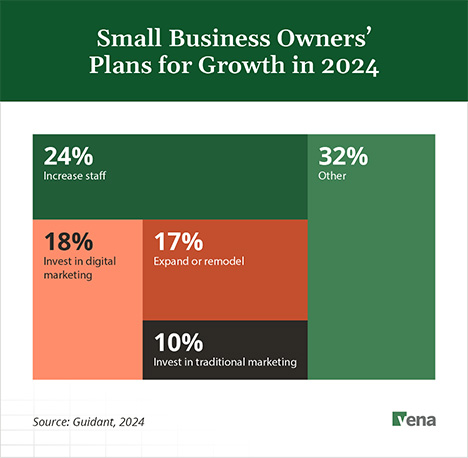Small manufacturing businesses are thriving, outperforming larger firms. Learn how to leverage their strategies for your own business growth.
By Lyric Mott
In an exciting turn of events, the manufacturing sector’s small businesses are leading the pack in terms of performance and profitability across various industries. This marks them as powerhouses of economic growth and as beacon lights offering invaluable insights for business expansion.
A recent data study has shone a spotlight on the remarkable ascent of small businesses within the manufacturing sphere, revealing a pattern of explosive growth.
In the final quarter of 2023, small manufacturing businesses significantly outperformed their counterparts in other sectors, securing the highest corporate profits of $780.8 billion across 385,570 businesses.
This achievement starkly contrasts with the second-highest industry, trade/transportation/utilities, which managed to garner $376.3 billion in profits distributed among more than 2 million small businesses. This notable discrepancy highlights the manufacturing sector’s robust profitability and emphasizes its dominant position within the small business landscape.
Benchmarking emerges as a vital strategy for any business aiming for continual improvement, allowing companies to measure their performance against industry standards to pinpoint strengths and weaknesses. For manufacturing firms, leveraging industry-specific benchmarks is especially critical in a landscape defined by cutthroat competition and rapid technological advancements. Through data-driven strategies, businesses can harness these insights to refine their operations, optimize resources, and significantly boost their revenue, ensuring they remain at the forefront of innovation and profitability.
The substantial growth in profitability witnessed in the manufacturing sector has been partially attributed to the implementation of the Inflation Reduction Act. This legislation could offer various incentives and financial benefits for manufacturing entities, ultimately fostering an environment conducive to increased innovation and efficiency. Though they come with risks, Such shifts are pivotal, as they may lead to reduced operational costs and augmented output, reinforcing the manufacturing sector’s competitive edge in the market.
As a result, manufacturers have seen reduced costs and increased demand for their products, which are crucial for boosting profits. The Act’s role in enhancing the economic landscape for these entities cannot be understated, as it has directly impacted their bottom line by creating more favorable conditions for production and sales.
Moreover, the Inflation Reduction Act has also played a pivotal role in encouraging investment in the manufacturing sector. By offering incentives for companies to innovate and expand their operations, the Act has unlocked new opportunities for growth and development.
This proactive approach to economic management has benefitted manufacturers and contributed to broader financial stability by fostering a more robust manufacturing industry and creating jobs.

In the competitive landscape of small manufacturing businesses, leveraging benchmark data to drive strategic decisions is crucial for growth and efficiency. Supply chain optimization emerges as a primary area for improvement, where companies can employ strategies like just-in-time inventory to reduce overheads and enhance operational flow.
Furthermore, technology adoption, particularly in automation and data analytics, is key to improving product quality and operational efficiency, positioning businesses to meet customer demands and expectations better.
Marketing innovation also plays a critical role in expanding a business’s reach and enhancing its market share. By utilizing data analytics to understand customer behaviors and preferences, small manufacturing firms can craft targeted marketing strategies that resonate with their audience, employing digital platforms to widen their visibility and engagement. This strategic approach consolidates their existing customer base and opens up new avenues for growth.
Exploring new market opportunities and developing new product lines based on emerging consumer trends and demands can significantly contribute to a small manufacturing business’s growth trajectory. Such expansion not only diversifies the business’s portfolio but also mitigates risks associated with market fluctuations. Small manufacturing businesses can improve their operations and secure a competitive edge for future growth and expansion by focusing on these key areas.

In conclusion, small manufacturing businesses stand out through their agility and innovation. To maintain and build on their success, it’s critical to prioritize benchmarking against leading industry practices for continuous improvement. Additionally, in today’s data-driven world, leveraging data analytics is essential for making informed decisions, optimizing operations, and improving customer satisfaction.
The future of these businesses hinges on adopting strategies that emphasize benchmarking and data utilization. This approach will not only secure their market position but also establish them as leaders in driving innovation and excellence. A firm commitment to these practices is the pathway to sustained growth and prosperity for small manufacturing businesses.

Lyric Mott is a seasoned financial content writer and editor who aims to empower individuals with clear, actionable information. Leveraging her diverse experience in crafting marketing materials and personal finance content, she creates SEO-driven content for FinTech companies at Siege Media. Her expertise lies in simplifying complex financial concepts, making them relatable, and empowering readers to take control of their financial future.
In this episode, I sat down with Beejan Giga, Director | Partner and Caleb Emerson, Senior Results Manager at Carpedia International. We discussed the insights behind their recent Industry Today article, “Thinking Three Moves Ahead” and together we explored how manufacturers can plan more strategically, align with their suppliers, and build the operational discipline needed to support intentional, sustainable growth. It was a conversation packed with practical perspectives on navigating a fast-changing industry landscape.